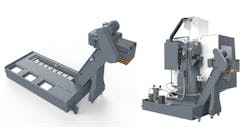Continuous learning is critical in manufacturing operations. The issue is that the pace of technological progress means that workers’ skills become outdated rather quickly, resulting in the manufacturing skills gap. While someone may have the skills needed to perform a job upon hiring, without continuous learning and ongoing training opportunities he or she risks losing upward career potential – and may even fall behind in the current role.
This is problematic for the individual and the employer. Workers who fail to succeed in their roles or advance in the organization likely will struggle financially as inflation drives up the cost of living. Already debt is a serious issue for workers, with the average American household debt now at $104,215. As the manufacturing sector accounts for a significant percentage of American jobs, this means workers’ debts could rise if they are unable to progress in their manufacturing careers.
For manufacturers, losing workers to skills gap issues is another aspect of the problem. Workers who do not feel their employers are invested in their career growth will move on and find work elsewhere. According to LinkedIn research, 94% of workers say they would be more likely to stay at a company if it invested in their career.
And high employee turnover significantly impacts a company’s bottom line. According to Gallup, the cost of replacing just one worker ranges from one-half to two times that employee’s annual salary.
Luckily, solving the skills-gap issue is not that difficult: The answer lies in developing a sound strategy that includes continuous learning through more accessible training opportunities.
Supporting continuous learning
Whether it’s upskilling to keep up with new technologies, policy changes, or evolving industry trends, continued learning is vital in manufacturing. Every workforce can benefit from continued learning support that offers significant advantages to both the organization and its employees.
1. Attract better talent — Finding and attracting top talent is much more of a challenge in today’s competitive landscape. Applicants look at more than just a good salary. Prospective employees want to see that an employer will be invested in his/her growth and provide opportunities for advancement. Thus, highlighting these opportunities by outlining continued learning practices in job postings and interviews can help attract better talent.
2. Improve retention rates — As noted, a significant percentage of workers have admitted to being more likely to stick around at a company that shows interest in helping them advance their careers. When employees feel their efforts are being wasted, or that they are not being offered the opportunities they need to succeed, they will quit and seek opportunities elsewhere. This not only stifles a manufacturer’s ability to retain talent; it may limit current and future revenue opportunities.
3. Fill skill gaps — Skills gaps are already an issue in manufacturing, where technology standards evolve rapidly. It’s easy to blame these gaps on industry shifts or unmotivated workers, but often the fault is with employers that do not provide workers access to educational opportunities. Training programs and other continuous learning resources must be made readily available, and woven into regular operations, to ensure workers skills are not falling behind the industry standards.
4. Drive innovation — Continuous learning is also critical in driving innovation. When workers have opportunities to learn and advance their skills, it can help them enhance their creative thinking and problem-solving skills. Both are vital to discovering new solutions to manufacturing problems and prompting new ideas that help drive business success.
5. Improve productivity — Continuous learning helps employees think more creatively, and encourages them learn to work smarter, which can improve productivity levels. It’s a basic concept that when employees work on skills development they are able to work more productively and make better use of their time.
6. Increase employee engagement — When given more opportunities to excel, workers are more likely to feel satisfied and engaged. This means they will be more invested in their own improvement and career mobility, and they will show more interest in helping the business achieve its goals.
7. Improve safety — Skill gaps are also problematic in regard to workplace safety, and especially in manufacturing. To ensure workers are using equipment properly, they must be consistently trained in proper safety protocols. The more knowledge they are given, the better they can perform their jobs safely and productively.
8. Keep up with laws and regulations — Policy and regulation changes are another important reason to support continuous learning in the workplace. As industry changes, laws and regulations are revised to meet the changes.
By adopting continuous learning practices, manufacturers ensure workers have the skills they need to succeed and continue to comply with policy.
Training programs and continuous learning
The key to continuous learning is to make training and educational resources easily accessible and readily available. Upon hiring workers should be provided with every resource and opportunity to continue developing their skills and knowledge. And all employees should be reminded regularly of the resources that are available to help them improve and advance in their careers.
Hands-on workshops. Workshops and training programs are crucial in the manufacturing setting. An instruction manual or educational video goes only so far. When dealing with complex equipment and processes, employees must have access to live, interactive training so they can get real-world hands-on experience.
Some examples of things that can be taught/learned in workshop settings include production floor safety, metallurgy, workholding principles, CNC controls and programming, and inspection methods. Workshops or training on the job can be customized to suit the specific needs of workers and the skills gaps that are present.
Online courses. Though in-person training is often best, supplemental learning should not be overlooked. Workshops take up a lot of time, so providing access to online courses is essential for workers who need a more flexible learning opportunity. Digital courses also are a great way to get an overview of new ideas and concepts that can be tested and put to use in live workshops.
There are numerous online courses and certificate programs, with everything from beginner to advanced knowledge for machinists, including courses on reading schematics, basic electricity, machine shop practice, metal cutting fundamentals, and more. If there is something a worker is interested in learning, it’s likely there is an online course for it.
Apprenticeship or mentorship. Apprenticeships and mentorship programs are great opportunities for those who show interest in leveling up their career, such as advancing entry-level machinist to a CNC programmer.
Continuous learning is not simply about filling skills gaps for work an employee already performs; it’s also about providing opportunities for employees to advance to higher-paying positions. And it can be a great way to increase engagement by having employees shadow supervisors to learn directly from those in upper-level positions.
Career planning. Career planning is another way to encourage workers to improve their skills. A career plan is essentially a guide to the steps necessary to achieve desired career goals.
As part of the onboarding process, employers can work with new hires to help them create a career plan that may include goal setting, skills development, continuous learning, and networking. Part of such a plan should include regular performance evaluations, to ensure the employee is on track to achieve his/her goals.
As manufacturers address workforce development, adopting a sound strategy for upskilling and continuous learning will become increasingly vital. As part of this strategy, employers will need to perform evaluations to understand better what skills are needed and where there are gaps to be filled. Once this issue is addressed, manufacturers can identify the appropriate training and learning opportunities to meet the needs of their workforce.
Ainsley Lawrence is a freelance writer and editor. Her most recent contribution is Unlocking the Power of Data Analytics.








